Reprinted from CAT in the December 1995 RootesReview
Submitted by Mike Schreiner
The Ford Toploader transmission was introduced in 1964 to replace the Borg Warner T-10. This is the super-tough transmission built by Ford Engineers to stand-up to just about anything demanded from it.
Internal parts of the Toploader are assembled through the top of the case instead of through a side cover, thus the name “Toploader”. This design is actually stronger than a 4-speed box with a side cover. The shifter shafts are mounted in bosses that are cast into the box itself, leaving the only function for the top cover to keep the lube inside.
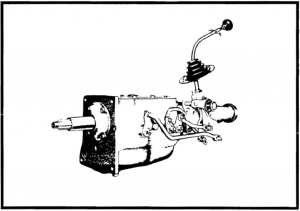
The Toploader 4-speed transmission is of the fully synchronized type with all gears except the reverse sliding gear being in constant mesh. All forward speed changes are accomplished with synchronizer sleeves instead of sliding gears. The synchronizers will enable quicker shifts, greatly reduce gear clash, and permit down-shifting into any forward-speed gear while the car is moving. All forward-speed gears in the transmission are helical-type, however, the reverse sliding gear and the exterior of the first and second-speed synchronizer sleeve are spur-type gears.
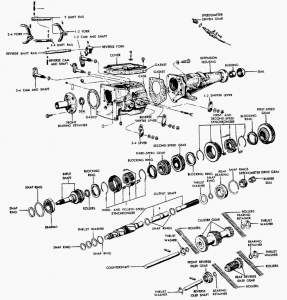 In first-speed, the first and second – speed synchronizer sleeve is moved rearward by the shift fork. The sleeve engages the first-speed blocking ring, which acts as a cone clutch applied to the free-wheeling first-speed gear. This action speeds up or slows down the first-speed gear to match the speed of the output shaft. Further movement of the sleeve locks the first and second speed synchronizer hub to the first-speed gear by means of internal splines. On engagement of the clutch, power flows through the input shaft and gear to the meshed countershaft gear and thence to the first-speed gear. This gear transmits the power through the locked synchronizer hub to the transmission output shaft. All the other forward-speed gears are in idler motion, as they are all driven by the countershaft (cluster) gear, but they do not transmit power because they are not locked to the output shaft. All the forward-speed shifts are made in the same manner as the first speed shift, due to the constant-mesh features.
In first-speed, the first and second – speed synchronizer sleeve is moved rearward by the shift fork. The sleeve engages the first-speed blocking ring, which acts as a cone clutch applied to the free-wheeling first-speed gear. This action speeds up or slows down the first-speed gear to match the speed of the output shaft. Further movement of the sleeve locks the first and second speed synchronizer hub to the first-speed gear by means of internal splines. On engagement of the clutch, power flows through the input shaft and gear to the meshed countershaft gear and thence to the first-speed gear. This gear transmits the power through the locked synchronizer hub to the transmission output shaft. All the other forward-speed gears are in idler motion, as they are all driven by the countershaft (cluster) gear, but they do not transmit power because they are not locked to the output shaft. All the forward-speed shifts are made in the same manner as the first speed shift, due to the constant-mesh features.
The Toploader was used in production from 1964 to 1973 in almost every model Ford car and a few foreign cars.
A 1-1/16″ input shaft was used in motors from the 200cid to the 390cid while the 427, 428 and 429 used a large 1-3/8″ input shaft. The 427, 428 and 429 were available only with close ratio gears. While the 1-1/16″ input transmissions are available in both close & wide gear ratios.
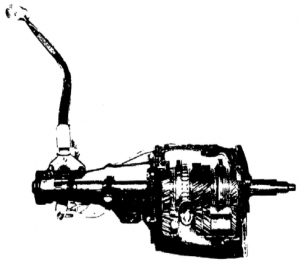 The gearbox was built in three case lengths. The 1964-65 Fairlane & Sunbeam Tiger case is 25-1/2″ long. The 1965-1973 AC Cobra with 427 cid, all Mustangs, Falcons, Mavericks, Cougars, Fairlanes, Comets, & pickups use 24″ transmissions, while all full sized cars & the 428, 429 Torino use the 27″ box. The 1964 Toploaders used a small 4-hole maincase with the small bearing retainer. All 1965-1973 cases were wide 8-hole cases with the large bearing retainer.
The gearbox was built in three case lengths. The 1964-65 Fairlane & Sunbeam Tiger case is 25-1/2″ long. The 1965-1973 AC Cobra with 427 cid, all Mustangs, Falcons, Mavericks, Cougars, Fairlanes, Comets, & pickups use 24″ transmissions, while all full sized cars & the 428, 429 Torino use the 27″ box. The 1964 Toploaders used a small 4-hole maincase with the small bearing retainer. All 1965-1973 cases were wide 8-hole cases with the large bearing retainer.
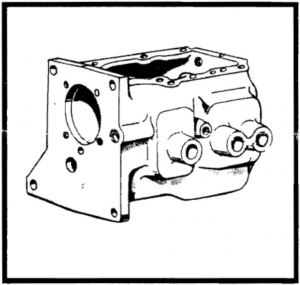
In 1964 and early 65 a few transmissions used a 25 spline output shaft.which proved to be defective. These were quickly dropped from production. Normally all motors 200cid – 390cid use the 28 spline output shaft. All 427-428-429 motors use the 31 spline output shaft. There are very few exceptions to the above information. The Toploader was produced in 133 different models.
Transmission Identification tag is located between the ears of the case on the right hand side, passenger side of the car.
Mike reports that this info came from Dan Williams of Franklin, N.C., a Toploader expert who offers parts and rebuilds.

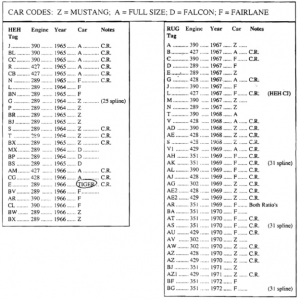
Comments (1)
What was the defect in the 1964 and early 1965 top loaders.